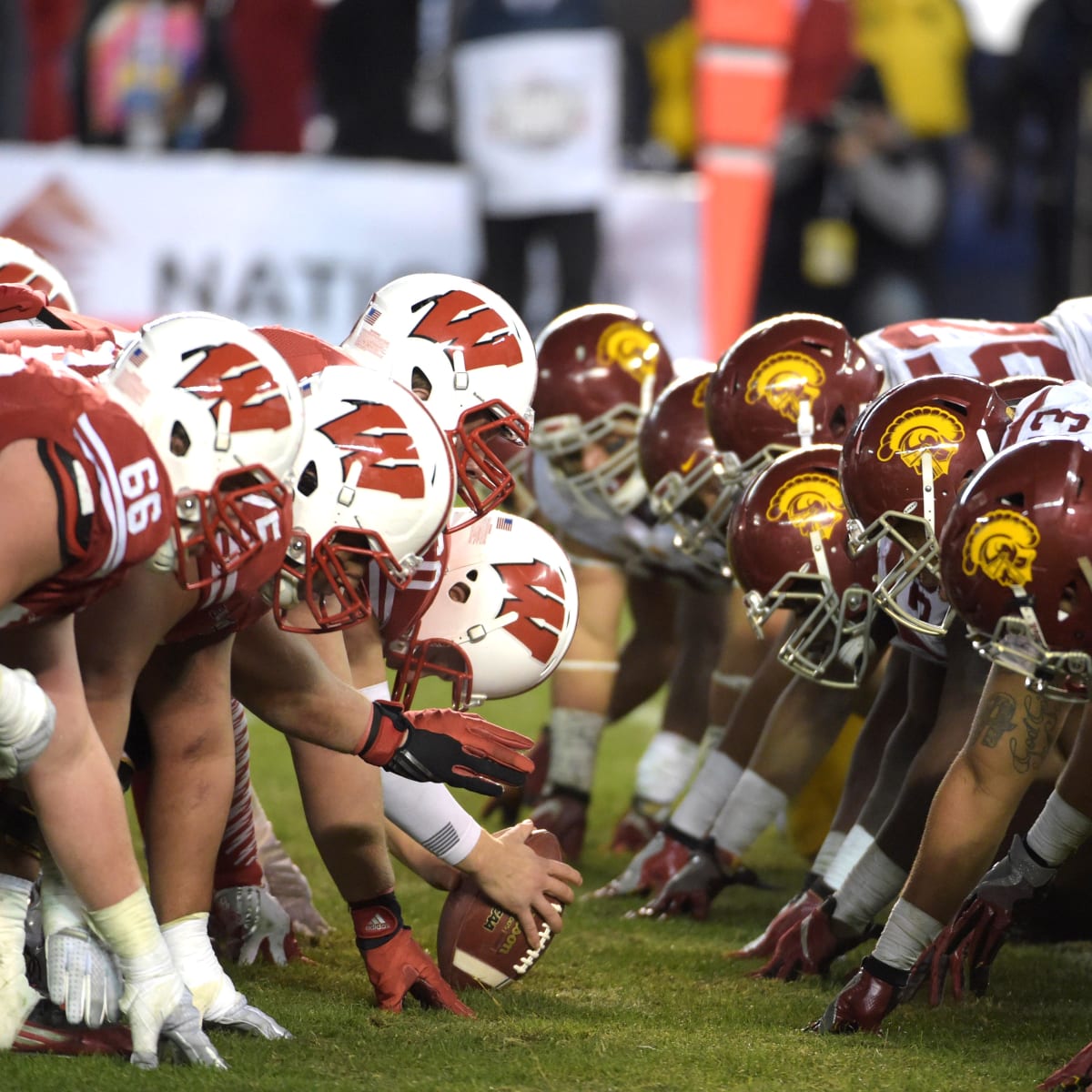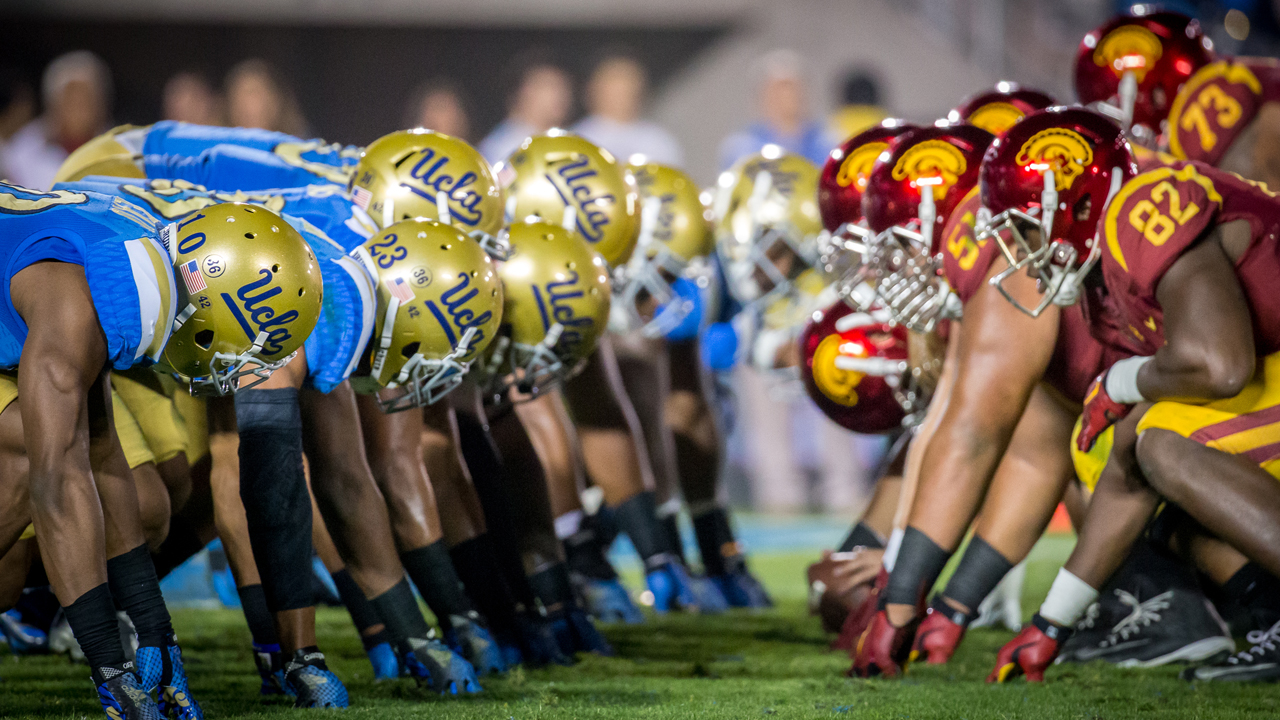
Last week, the Pac-12 announced that it was not seeking any expansion at this time in the wake of its announced Big Paclantic Alliance with the Big Ten and ACC. While some fans of schools remaining in the Big 12 that are hoping for another power conference home may cling to the “at this time” qualifier from the Pac-12, the practical reality is “at this time” really means, “We’re not expanding unless Notre Dame and schools such as, well, Texas and Oklahoma are coming through that door.”
Therefore, reality is setting in for the Big 12 that it will ultimately need to expand and, to that end, the league has formed an expansion subcommittee. At a minimum, the Big 12 will need to have at least 10 conference members after Texas and Oklahoma officially leave for the SEC in order for the league to maintain its current TV contracts with ESPN and Fox. Note that everyone from the Big 12, SEC, Texas and Oklahoma will all publicly state that no one is moving until 2025 in order to comply with their existing agreements. No one can even hint anonymously that there’s a possibility that UT and OU will leave the Big 12 prior to that time. However, in practicality, everyone knows that there will eventually be a settlement so that those schools aren’t spending the next 4 years in lame duck status that isn’t good for anyone. This means that the Big 12 has to be ready to act once it knows the UT/OU exit timeline and staying at 8 members simply isn’t an option.
Over the past decade (decade?!) in writing about conference realignment, I’ve had multiple posts about examining Big 12 expansion candidates complete with dated pop culture references ranging from Avicii to The Bachelor. In reviewing Big 12 expansion this time around, though, I felt that a straight ranking of the candidates really wouldn’t add much to the analysis. The interesting opportunity that the Big 12 has is that, as a result of its current roster of members with a potpourri of institutional types and geographic placement in the center of the country (except for West Virginia), the league can legitimately expand in any direction both philosophically and geographically. With only a small handful of exceptions, the realistic expansion candidates for the Big 12 essentially all have, in baseball terms, the same Wins Above Replacement Value where there aren’t glaring differences. As a result, expansion should be looked at holistically in terms of the overall strategies that the Big 12 could use. Putting on my consulting hat, here are 11 different Big 12 expansion strategies:
1. Lazy AF Bare Minimum Backfilling Strategy – Cincinnati and BYU
If it’s true that no realistic combination of expansion options for the Big 12 can bring in additional revenue and would only dilute per school shares, then it stands to reason that doing just the bare minimum to backfill to 10 members simply to keep the current conference TV contracts intact is high on the list of potential strategies. Cincinnati and BYU were generally looked at as the top targets for Big 12 expansion 5 years ago and that’s likely going to be the same today. (Heck, Cincinnati and BYU were even the two top schools in my Big 12 Expansion Index from 2013.) It’s not the most explosive or Armageddon-like path for the conference realignmentologists out there, but it might be the most realistic.
Out of all of the available schools, Cincinnati is the school that I believe is most likely to get a Big 12 invite. The Bearcats have a solid TV market, an excellent football recruiting area (which would be the best in the Big 12 outside of Texas), as good of an overall athletic history in both football and basketball as any other candidate, a great football program today, and (maybe most importantly) absolutely no baggage of potential issues with religious stances or in-state conflicts with current members. These are all reasons why Cincinnati is the only school that is listed in every single one of the strategies in this post.
Now, from a pure financial value standpoint, BYU is typically viewed to be the most valuable potential addition to the Big 12 due to its TV viewership history and fanbase size. The challenge with BYU is the “baggage” in past objections from other Big 12 members regarding BYU’s Honor Code and its treatment of members of the LGBTQ+ community and the real or perceived difficulty of negotiating with the school in its past conference realignment discussions with both the old Big East football conference and Big 12. That being said, The Athletic quoted a Big 12 source stating that the ones that opposed adding BYU 5 years ago are the ones “leaving the conference”, so the barriers to BYU getting an invite to the league might have come down.
Of course, the flip side is that BYU, with its independent TV contract with ESPN and BYUtv, might be the only school outside of the Power Five that could conceivably turn down a Big 12 invite. Personally, I find that prospect to be doubtful if/when we have an expanded 12-team playoff system with guaranteed spots to the top 6 conference champs, but no one should discount the fact that BYU has different institutional goals compared to any other place in the country. If BYU won’t come or can’t get into the Big 12 for any reason, look for one of either Houston or UCF (both of which will be discussed in the next strategy) to take their place.
2. You Come at the King, You Best Not Miss Strategy – Cincinnati, BYU, Houston, and UCF
One of the cardinal rules that we have learned over many years of expansion analysis: S**t ALWAYS rolls downhill in conference realignment. That is, any time that a league lower on the pecking order thinks that it could poach a conference that’s higher on the pecking order, that’s exactly when the lower league gets completely demolished. (See the old Big East football conference, Mountain West Conference and WAC in the early 2010s.) When Big 12 commissioner Bob Bowlsby publicly accused ESPN of engaging in a conspiracy to get the AAC to raid the Big 12, I wrote that this might have changed the Big 12’s attitude from taking as few AAC schools as possible (see the Lazy AF Bare Minimum Backfilling Strategy above) to trying to take as many AAC schools of value as possible. This ensures that there’s no chance that a reverse raid occurs in the future or that the CFP committee in a 12-team playoff world is trying to debate whether the Big 12 or AAC champion faced a tougher conference schedule in fighting for a playoff spot.
Houston is a school that should be in the Big 12 with its institutional and geographic fit combined with being directly located in one of the most important markets for the conference and an excellent athletic program for both football and basketball (including a New Year’s Six Bowl win in 2015 and a Final Four appearance this past year). If Houston (the school) was located anywhere outside of the state of Texas, it would essentially be a lock for Big 12 expansion. The one major wrinkle is that Texas Tech, Baylor and TCU may very well not want to elevate an in-state competitor, which is a theme that we have seen throughout conference realignment history. The Athletic mentioned that some in the Big 12 had issues with in dealing with UH board chair Tilman Fertitta in 2016, although my intuition is that’s cover for the more likely reason of in-state conflicts of interests. If I were running the Big 12, I would absolutely add Houston and this particular strategy would be the one that I’d favor the most.
When the Big 12 was looking at expansion in 2016, the league essentially looked at UCF and USF as effectively tied in a coin flip. That’s not the case any longer with UCF’s on-the-field success and building of its brand over the past several years. Today, UCF arguably brings the most pure football value of any option in the AAC along with new entry into the Orlando TV market and recruiting grounds.
3. TV Executives Will Tell Us What to Do Strategy – Cincinnati, BYU, UCF, Boise State
In the above-referenced article from The Athletic on the Big 12 expansion process, the schools in this strategy were ones specifically named as possibly maximizing football and TV value for the league. Whether that was pure writer speculation or more of an informed opinion is unknown (although my gut feeling is that those names were just thrown against the wall within the context of that article). From a pure football perspective, Boise State might have the best brand value of any Group of 5 team (despite not performing as well on-the-field compared to several AAC options recently), so they are one of the few expansion options with a solid recent history of on-the-field success and corresponding TV viewership.
4. Life After Death Southwest Conference Strategy – Cincinnati, Houston, SMU, and Rice
My head says that this expansion strategy won’t be used by the Big 12, but my heart really wishes that it would. In most conference realignment situations, the reality is that the resulting matchups when games finally get played lack any history or general emotions at all. (Recall the Civil Conflict “rivalry” between UCF and UConn in the AAC where UCF didn’t even acknowledge the existence of the trophy that UConn created.) That won’t be the case here: nothing will be forced. The hate will be real with Houston, SMU and Rice (yes, Rice!) getting into the very league whose creation destroyed the Southwest Conference and demoted them to non-power status for the past 25 years. The rivalries between the those 3 schools and Baylor, Texas Tech and TCU are longstanding and, in some cases, date back over a century. While the main weakness of the Big 12 up to this point has been its overconcentration in the Texas market, that may now be its greatest asset going forward as it rebuilds. So, the strategy here would be to lean into that asset. It may be better to be the clear #2 conference in the State of Texas than to be the #3 conference in Florida or even the #2 conference anywhere else. Honestly, this is the most fun option for me as a sports fan.
5. Stealing Magnolias Strategy- Cincinnati, SMU, Rice, and Tulane
Back in the 1950s and 1960s, there were various discussions of the creation of a “Southern Ivy League” of top academic private schools that was colloquially known as the “Magnolia League” and involved SMU, Rice and Tulane. As I’ve noted previously as the most important rule in conference realignment: Think like a university president and not like a sports fan. This strategy would fit into the university president’s typical desire to raise the academic pedigree of a league. While this may not be the best path to improve football quality, the argument here would be that getting AAU members like Rice (yes, Rice again!) and Tulane would have a greater institutional impact in being academic peers to a critical mass of members of the other power conferences. Even with the defections of Texas and Oklahoma, the actual on-the-field football product for the Big 12 will likely still be very good, but the challenge is about how the league’s members are perceived as overall institutions compared to the rest of the Power 5. Tulane provides a bonus of being directly located in a solid TV market (and world class road trip destination) of New Orleans and opens up another fertile recruiting area.
6. All My Exes Live in Texas Blackballing Strategy – Cincinnati, BYU, UCF, and 1 of either Memphis or USF
Going in the other direction from the Life After Death Southwest Conference strategy, it wouldn’t surprise anyone if Baylor, TCU and Texas Tech form a voting bloc that would blackball any other Texas-based additions to the Big 12 altogether. As noted in the initial discussion on Houston, whether it’s fair or not, protecting the home territory of existing conference members has long been a major factor in realignment decisions. Essentially, this is the You Come at the King, You Best Not Miss Strategy with Houston removed and the last spot being a choice between Memphis and USF. Memphis is in an excellent college sports market that brings a fair amount of historical pedigree for both football and basketball. Meanwhile, USF creates synergy as a pair with UCF in solidifying a presence in the Central Florida region where any school that isn’t Florida or Florida State can’t carry on its won. My feeling is that Memphis would win out due to it being stronger as an overall athletic program, although there might be an overarching desire of the Big 12 to create a more impactful presence in Florida.
7. The Mountains Win Again Strategy – Cincinnati, BYU, Colorado State, and Boise State
The options discussed up to this point have focused on the Big 12 adding schools to the East outside of BYU. However, there’s a fair argument that going West would be better long-term in order to get the conference into a less competitive region of the country that is also fast-growing. The Big 12 (and old Big 8, for that matter) used to have Colorado as a key member before they defected to the Pac-12. This strategy works best with building around BYU and Boise State. Colorado State has long been at the top of the list of schools that would improve its conference realignment prospects drastically if it could be merely consistently competent in football since it has so many off-the-field factors in favor of it in terms of academic profile and a location in a state that is exploding with growth. .
8. Return of the WAC Strategy – Cincinnati, BYU, Colorado State, Boise State, New Mexico, San Diego State, UNLV, and Air Force (alternate: anyone else from the Mountain West Conference)
Taking The Mountains Win Again Strategy one step further, once upon a time, the WAC was a 16-team superconference with games going on at all hours of the evening. The Big 12 could resurrect that model by going big with many of the same teams that were involved in that WAC format. Essentially, this is a full-on raid of the Mountain West Conference. San Diego and Las Vegas markets are two of the largest TV markets that don’t have a direct or de facto connection to a power conference team, so the Big 12 could serve a need in those areas with San Diego State and UNLV, respectively. (Recall that Boise State and San Diego State were willing to join the old Big East football conference for a few moments before conference realignment further took its toll and they decided to re-up with the Mountain West.) Air Force further solidifies the Rocky Mountain region with some national brand value as a military academy. The Falcons have also been willing to play a higher level of competition for basketball and other non-football sports compared to their other military academy brothers of Army and Navy (who will be discussed later on in this post), although the school expressed concern about competing in a power conference in the past. In the event that Air Force doesn’t want to move, the Big 12 would effectively being throwing at a dartboard at a map of the MWC for which school gets the last spot. (Fresno State? San Jose State? Nevada? Wyoming? Utah State? Heck, Hawaii? It’s totally unclear who would win that battle.)
9. Big Country Conference Strategy – Cincinnati, BYU, UCF, Boise State, Colorado State, San Diego State, UNLV, and Houston (alternate: either Memphis or USF)
Further to my last point, the old Big East attempted to put together a coast-to-coast football conference in 2012 in the wake of the ACC raiding that league of Syracuse and Pitt and the Big 12 grabbing West Virginia. However, the plan was killed when the league was raided again by the Big Ten (Rutgers) and ACC part 2 (Louisville) shortly thereafter. That’s too bad since they were employing a variation of one of my favorite blue sky ideas from the crazy conference realignment days of 2010: a coast-to-coast football-only Big Country Conference of the Big East plus the best of the then-non-AQ conference schools. For football purposes, today’s proposed Big Country Conference would be a super-fun league that can deliver 14-plus hours of games for TV networks every Saturday (plus plenty of willingness to fill weeknight time slots). The challenge would be that this may not be realistic as an all-sports league for the West members since there isn’t a critical mass of schools in that part of the country (unlike the Return of the WAC option). If those schools As a result, football-only memberships for those schools would require some coordination with a league like the Big West or West Coast Conference to take those Western schools as members for basketball and other sports.
10. I Wish I Was a Little Bit Taller, I Wish I Was a Baller Strategy – Cincinnati, BYU, Houston, Memphis, Temple, and UConn
It is a common refrain that “football is all that matters for conference realignment.” However, I would push back on the universality of that statement. While it’s true that the top power conferences such as the Big Ten and SEC are making so much revenue that football is really the only sport that can make a material difference, that isn’t necessarily true at the lower levels. Case in point is the new Big East that has been able to thrive both on-the-court and off-the-court financially based on basketball and no longer needing to deal with football members.
Also note the situation in the Big 12 where the most valuable school left for conference realignment purposes happens to be Kansas… and that is due entirely to its status as a blue blood basketball program. As a result, Kansas may very well have the most influence in Big 12 expansion discussions, which means that basketball prowess could become more of a factor in the decision-making. In this case, 3 AAC schools that we have discussed at length already (Cincinnati, Houston and Memphis) are included along with UConn, Temple and BYU. Granted, it’s hard to see UConn switching conferences again after leaving the AAC and going “home” to the Big East for basketball last year while turning independent for football. However, if the Big 12 is looking to really focus on its basketball brand (which will still be excellent with blue blood Kansas, reigning national champion Baylor, alma mater of the latest #1 pick of the NBA Draft in Cade Cunningham in Oklahoma State, and the national runner-up from 2 years ago in Texas Tech), then UConn has the best available brand on the table. Temple also has an excellent basketball history and would bring in the Philadelphia area that, while being perceived as a weak college football fan market, is actually a strong college basketball region with great rivalries in the Big 5.
11. Shock and Awe Strategy – Cincinnati, BYU, Air Force, Navy (football-only), Army (football-only), and 1 of either Houston or UCF
Andy Staples of The Athletic recently wrote about the importance of the 4 Million Club, where TV value is driven by games that draw more than 4 million viewers. The SEC and Big Ten have excelled on this measure since 2015, so it’s not a surprise that they draw in the most TV revenue of any conferences by far. The weakness of the Pac-12 and Big 12 (not counting Texas and Oklahoma games) by comparison was also stark. In looking through the source ratings data at Sports Media Watch, one interesting tidbit is that out of 193 college football telecasts that drew more than 4 million viewers since 2015, only 6 didn’t involve at least one Power Five team (including Notre Dame)… and 5 of those 6 games were Army-Navy games. If the Big 12 could actually make the Army-Navy game into a contest that falls under the conference contract, that may be worth more from a TV value standpoint than any other possible addition. Add in Air Force on top of that and the Big 12 would have all three service academies under its wing. Cincinnati, BYU and Houston or UCF can also be added for depth across all sports.
Now, the Army-Navy game currently has a separate TV contract with CBS, which was a requirement of Navy upon joining the AAC as a football-only member and means that league doesn’t receive any revenue from that matchup. Whether that can be adjusted would make a significant difference as to whether going for an expansion strategy focused on adding the service academies would be financially viable. In any event, Navy, Army and Air Force all do bring national brands that are hard to come by outside of the power conferences.
If I’m handicapping the field, I’d rank the following strategies in terms of likelihood: (1) You Come at the King, You Best Not Miss Strategy, (2) Lazy AF Bare Minimum Backfilling Strategy, (3) TV Executives Will Tell Us What to Do Strategy, and (4) the rest of the field. (EDIT: Thinking about this further, the All My Exes Live in Texas Blackballing Strategy ought to be included on this list. I would move that up to the #3 choice.) It’s not an accident that the same schools such as Cincinnati, BYU, UCF, Houston and Boise State are the ones that are being discussed the most along with a small handful of others. The Big 12 already went through an expansion evaluation in 2016, which would seem to make the process this time around much more efficient in theory. The real question is where the Big 12 wants to go, both literally and figuratively, as their strategies are all across the map.
(Image from IMDb)



 It has been a whirlwind for the past three weeks since the Big Ten announced that it was expanding with USC and UCLA. I have a lot of thoughts on what the Big Ten will (or more likely, won’t) do in terms of further expansion, the fight for the upper hand between the Pac-12 and Big 12, and how conference realignment may impact the playoff.
It has been a whirlwind for the past three weeks since the Big Ten announced that it was expanding with USC and UCLA. I have a lot of thoughts on what the Big Ten will (or more likely, won’t) do in terms of further expansion, the fight for the upper hand between the Pac-12 and Big 12, and how conference realignment may impact the playoff.





